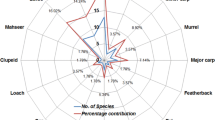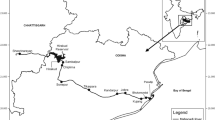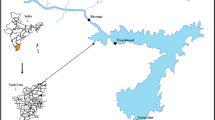Abstract
In the present communication habitat ecology, species diversity; distribution and different indices of fish biodiversity management were studied in a Central India river (River Betwa, a tributary of River Ganga basin approved under India’s first river linking plan). Correlation between fish species richness with the hydrological attributes showed good relationship and water depth, dissolved oxygen and pH were found the most important variables in shaping fish assemblage. Altogether, sixty-three fish species belonging to 20 families and 45 genera were collected from five sampling stations spread along the upstream, mid stream and lower streams. Cyprinids were the most dominated group represented by 26 species belonging to 15 genera, followed by Bagridae (6 species from 3 genera), and Schilbeidae (4 species from 4 genera). The distribution of fish showed interesting pattern and about 10% species were common to all the sites showing long migration range. Shannon-Weiner diversity index showed considerable variation and ranged from 1.89 to 3.51. Out of 63 species status of 10 species were not known due to data deficit, 29 categorized as lower risk, 14 as vulnerable, 8 as endangered, while the remaining two species were introduced. Our study shows that the River supports considerable diversity of the fishes and is important for conservation and about 34% fish fauna is threatened being either vulnerable or endangered. We assessed that the river supports considerable percentage of food fish (89.47), ornamental fish (49.12%) and sport fish (5.26%). Among the eight major types of fish habitats identified along the entire stretch of river, open river, shallow water and deep pools were habitats contributing maximum diversity. Fish species richness (FSR) were significantly different (P < 0.05) in all the habitats except channel confluence and scour pool. Trophic niche model may be useful for assessing altered as well as less altered fish habitat of the tropical rivers. Since this river will be interlinked in near future, this study would be useful for conservation planning and management and also for future assessment after interlinking. Issues related to various threats to aquatic environment and conservation management strategies have been discussed.








Similar content being viewed by others
References
Aadland LP (1993) Stream habitat types: their fish assemblages and relationship to flow. North Am J Fish Manag 13:790–806
Adholia UN (1977) Fish fauna of the River Betwa. Geobios 4(6):272–273
Armantrout NB (1999) Glossary of aquatic habitat inventory terminology. American Fisheries Society, Bethesda
Arunachalam M (1999) Methods for fish habitat inventory in streams/Rivers. In: Proceedings of workshop germplasm inventory and gene banking of freshwater fishes. National Bureau of Fish Genetic Resources, Lucknow, India
Arunachalam M (2000) Assemblage structure of stream fishes in the Western Ghats (India). Hydrobiologia 430:1–31
Bain MB, Stevenson NJ (1999) Aquatic habitat assessment. Asian Fisheries Society, Bethesda
Bayley P, Li H (1994) Riverine fisheries. In: Calow P, Petts GE (eds) The river handbook: hydrological and ecological principles. Blackwell, Boston, pp 251–281
Biswas SP (1993) Manual of methods in fish biology. South Asian Publishers, New Delhi
Boruah S, Biswas SP (2002) Ecohydrology and fisheries of the upper Brahmputra basin. Environmentalist 22:119–131
Bunn SE, Arthington AH (2002) Basic principles and ecological consequences of altered flow regimes for aquatic biodiversity. Environ Manag 30:492–507
Chaube UC (1988) Model study of water use and water balance in Betwa Basin. J Inst Eng Indian Civil Eng Div 69:169–173
Chovance A, Hoffer R, Schiemer F (2003) Fish as bioindicators. In: Market BA, Breure AM, Zechmeiser HG (eds) Bioindicatos and biomonitors, pp 639–675
Colwell (1996) User’s guide to estimates—statistical estimation of species richness and shared species from samples. Version 8. User’s guide and application published at http://viceroy.eeb.uconn.edu/estimates
Copp GH, Bianci Bogutskaya NG, Eros T, Falka I, Ferreira MT, Fox MG, Freyhof J, Gozlan RE, Grabowska J, Kovac V, Moreno-Amich R, Naseka AM, Wiesner C (2005) To be, or not to be, a non-native freshwater fish? Appl Ichthyol 21:242–262
Corbacho C, Sanchez MJ (2001) Patterns of species richness and introduced species in native freshwater fish faunas of a Mediterranean-type basin: the Guadiana River (southwest Iberian Peninsula). Regul Rivers Res Manag 17(6):699–707
Darwall WRT, Vie JC (2005) Identifying important sites for conservation of freshwater biodiversity: extending the species-based approach. Fish Manag Ecol 12:287–293
Das MK (2007) Environment and fish health: a holistic assessment of inland fisheries in India. In: Goswami UC (ed) Natural and anthropogenic hazards on fish and fisheries. Narendra Publishing House, Delhi, pp 137–151
Das SK, Chakrabarty D (2007) The use of fish community structure as a measure of ecological degradation: a case study in two rivers of India. Bio Syst 90:188–196
Dawson TP, Berry PM, Kampa E (2003) Climate change impacts on freshwater wetland habitat. J Nat Conserv 11:25–30
De Silva SS, Abery NW, Nguyen TTT (2007) Endemic freshwater finfish of Asia: distribution and conservation status. Divers Distrib 13:172–174
Dudgeon D, Arthington AH, Gessner MO, Kawabata ZI, Knowler DJ, Leveque C, Naiman RJ, Prieur-Richard AH, Soto D, Stiassny MLJ, Sullivan CA (2006) Freshwater biodiversity: importance, threats, status and conservation challenges. Biol Rev 81:163–182
Flores S, Araya PR, Hirt LM (2009) Fish diversity and community structure in a tributary stream of the Parana River. Acta Limnol Bras 21(1):57–66
Froese R, Pauly D (Eds) (2010) FishBase. World Wide Web electronic publication. http://www.Wshbase.org, Cited February 2010
Fu C, Wu J, Chen J, Wu Q, Lei G (2003) Fresh water fish biodiversity in the Yangtze River basin of China: patterns, threats and conservation. Biodivers Conserv 12:1649–1685
Fukushima M, Kameyama S, Kaneko M, Nakao K, Steel EA (2007) Modelling the effects of dams on fresh water fish distribution in Hokkaido, Japan. Freshw Biol 52:1511–1524
Gibbs JP (2000) Wetland loss and biodiversity conservation. Conserv Biol 14(1):314–317
Granado C (2000) Ecologa de communidades el paradigma de los pecces de agua dulce. Universidad de Sevilla Secretariado de Publicaciones, Sevilla
Growns I, Gehrke PC, Astles KL, Pollard DA (2003) A comparison of fish assemblage associated with different riparian vegetation types in the Hawksbury-epan River system. Fish Manag Ecol 10:209–220
Habit E, Belk MC, Tuckfield RC, Parra O (2006) Response of the fish community to human-induced changes in the Biobio River in Chile. Freshw Biol 51:1–11
Jayaram KC (1981) Fresh water fishes of India—hand book. Zoological Survey of India, Calcutta
Jayaram KC (1999) The freshwater fishes of the Indian Region. Narendra Publishing House, Delhi, p 551
Johal MS, Tandon KK, Tyor AK, Rawal YK (2002) Fish diversity in different habitats in the streams of lower Middle Western Himalayas. Polish J Ecol 50:45–56
Kang B, He D, Perrett L, Wang H, Hu W, Deng W, Wu Y (2009) Fish and fisheries in the Upper Mekong: current assessment of the fish community, threats and conservation. Rev Fish Biol Fish 19:465–480
Karr JR, Fausch KD, Angermeier PL, Yant PR, Schlosser IJ (1986) Assessing biological integrity in running waters. A method and its rationale. Illinois Natural History Survey Campaigne. Special Publications, Illinois, 28 pp
Laffaille P, Acou A, Guillouet J, Legult A (2005) Temporal change in European eel, Anguilla anguilla, stock in a small catchment after installation of fish passes. Fish Manag Ecol 12:123–129
Lakra WS, Sarkar UK (2007) Freshwater fish diversity of central India. Edited and published by National Bureau of Fish Genetic Resources, Lucknow, pp 1–183
Leveque C, Balian EV, Martens K (2005) An assessment of animal species diversity in continental waters. Hydrobiologia 542:32–67
Lima-Junior SE, Cardone IB, Goitein R (2006) Fish assemblage structure and aquatic pollution in a Brazilian stream: some limitations of diversity indices and models for environmental impact studies. Ecol Freshw Fish 15(3):284–290
Lobb MD, Orth DJ (1991) Habitat use by an assemblage of fish in a large warm water stream. Trans Am Fish Soc 120:65–78
Manojkumar TG, Kurup BM (2002) Fish habitat diversity and species assemblage structure with reference to five major systems of Kerala In: Boopendranath MR, Meenakumari B, Joseph J, Sankar TV, Pravin P, Edwin L (eds) Proceedings of riverine and reservoir fisheries of India. Society of Fisheries Technologists (India), Cochin, pp 141–150
Mas-Marti E, Garcia-Berthou E, Sabater S, Tomanova S, Monoz I (2010). Comparing fish assemblages and trophic ecology of permanent and intermittent researches in a Mediterranean stream. Hydrobiologia. doi:10.1007/s10750-010-0292-x
Mishra DN, Moza U (1997) Changing senario of fish and fisheries of River Yamuna—part II. In: Vass KK, Sinha M (eds) Changing perspectives of inland fisheries. Proceedings of the national seminar, march 16–17, 1997, Inland Fisheries Society of India, Barrackpore, pp 57–62
Morita K, Morita SH, Yamamoto S (2009) Effects of habitat fragmentation by damming on salmonid fish: lessons from white-spotted Charr in Japan. Ecol Res 24(4):711–722
Motita K, Yokota A (2002) Population viability of stream-resident salmoids after habitat fragmentation: a case study with white-spotted Charr (Salvelinus leucomaens). Ecol Modell 155:85–94
NWDA (National water development agency)/Tech.III/122/17/2004. V. http://www.nwda.gov.in
Pandey RP, Mishra SK, Singh R, Ramasastri KS (2008) Streamflow drought severity analysis of Betwa River system (India). Water Res Manag 22:1127–1141
Payne AI, Sinhua R, Singh HR, Huq S (2004) A review of the Ganges basin; its fish and fisheries. In: Welcome RL, Petr R (eds) Proceedings of the second international symposium on the management of large rivers for fisheries, vol 1. Food and Agriculture Organization of the United Nations, Regional Office for Asia and the Pacific; Mekong River Commission (MRC), Fisheries Programme (FP), pp 229–251
Peres-Neto PR (2004) Patterns in the co-occurrence of stream fish metacommunties: the role of site suitability, morphology and phylogeny versus species interactions. Oecologia 140:352–360
Raghavan R, Prasad G, Anvar Ali PH, Pereira B (2008a) Fish fauna of Chalakudy River, part of Western Ghats biodiversity hotspot, Kerala, India: patterns of distribution, threats and conservation needs. Biodivers Conserv 17:3119–3131
Raghavan R, Prasad G, Anvar Ali PH, Pereira B (2008b) Exotic fish species in a global biodiversity hotspot: observations from River Chalakudy, part of Western Ghats, Kerala, India. Biol Invasions 10:37–40
Rahel FJ, Bierwagen B, Taniguchi Y (2008) Managing aquatic species of conservation concern in the face of climate change and invasive species. Conserv Biol 22(3):551–561
Ricciardi A, Rasmussen JB (1999) Extinction rates of North American freshwater fauna. Conserv Biol 13:1220–1222
Sarkar UK, Bain MB (2007) Priority habitats for the conservation of large River fishes in the Ganges River basin. Aquat Conserv Mar Freshw 17:349–359
Sarkar UK, Pathak AK, Lakra WS (2008) Conservation of freshwater fish resources of India: new approaches, assessment and challenges. Biodivers Conserv 17:2495–2511
Sarkar UK, Gupta BK, Lakra WS (2010) Biodiversity, ecohydrology, threat status and conservation priority of freshwater fishes of River Gomti, a tributary of River Ganga (India). Environmentalist 30:3–17
Scrimgeour G, Chambers P (2000) Cumulative effects of pulp mill and municipal effluents on the epilithic biomass and nutrient limitation in a large northern river ecosystem. Can J Fish Aquat Sci 57:1342–1354
Shaffer AJ, Beirne M, Ritchie T, Paradis R, Barry D, Crain P (2009) Fish habitat use response to anthropogenic induced changes of physical processes in the Elwha estuary, Washington, USA. Hydrobiologia 636:179–190
Shahnawaz A, Venkateshwarlu M, Somashekar DS, Santosh K (2010) Fish diversity with relation to water quality of Bhadra River of Western Ghats (India). Environ Monit Assess 161:83–91
Shannon CE, Wiener W (1963) The mathematical theory of communication. University Illinois Press, Urbana pp36.
Specht WL, Paller MH (2004) Macroinvertebrate assessments of 22 locations in SRS streams, in support of the Integrator Operable Unit Program, July–August 2003. WSRC-TR-2004-00482
Sreekantha KV, Ramachandra TV (2005) Fish diversity in Linganamakki Reservoir, Sharavathi River. Ecol Environ Conserv 11:337–348
Srivastava GJ (1988) Fishes of U.P. and Bihar, 3rd edn. Viswa Vidyalaya Prakashan, Varanasi
Statsoft Inc (1999) Electronic statistics textbook. TulsaStatsof, OK. Web: http://www.statsoft.com/textbook/stathome.html
Szollosi-Nagy (2004) In: Proceedings of the United Nations seminar, 25–26 November 2004, Delft, Netherlands
Talwar PK, Jhingran A (1991) Inland fishes of India and adjacent countries, 2 volumes. Oxford and IBH Publishing Co. Pvt. Ltd., New Delhi, xix + 1158 pp
Welcomme RL (1985) River fisheries. FAO Fish Tech Pap 262:1–318
Wichert GA, Rapport DJ (1998) Fish community structure as a measure of degradation and rehabilitation of riperine systems in an agricultural drainage basin. Environ Manag 22(3):425–443
Wolter C, Minow J, Vilcinskas A, Grosch U (2000) Long-term effects of human influence on fish community structure and fisheries in Berlin water: an urban water system. Fish Manag Ecol 7:97–104
Yamamoto S, Morita K, Koizumi I, Maekawa K (2004) Genetic differentiation of white spotted Charr (Salvelinus leucomaens) population after habitat fragmentation: spatial-temporal changes in gene frequencies. Conserv Genet 5:529–538
Acknowledgments
We are grateful to the Department of Biotechnology (DBT) Govt. of India, New Delhi for financial support to carry out the present investigation.
Author information
Authors and Affiliations
Corresponding author
Appendix 1
Appendix 1
See Table 4.
Rights and permissions
About this article
Cite this article
Lakra, W.S., Sarkar, U.K., Kumar, R.S. et al. Fish diversity, habitat ecology and their conservation and management issues of a tropical River in Ganga basin, India. Environmentalist 30, 306–319 (2010). https://doi.org/10.1007/s10669-010-9277-6
Published:
Issue Date:
DOI: https://doi.org/10.1007/s10669-010-9277-6




